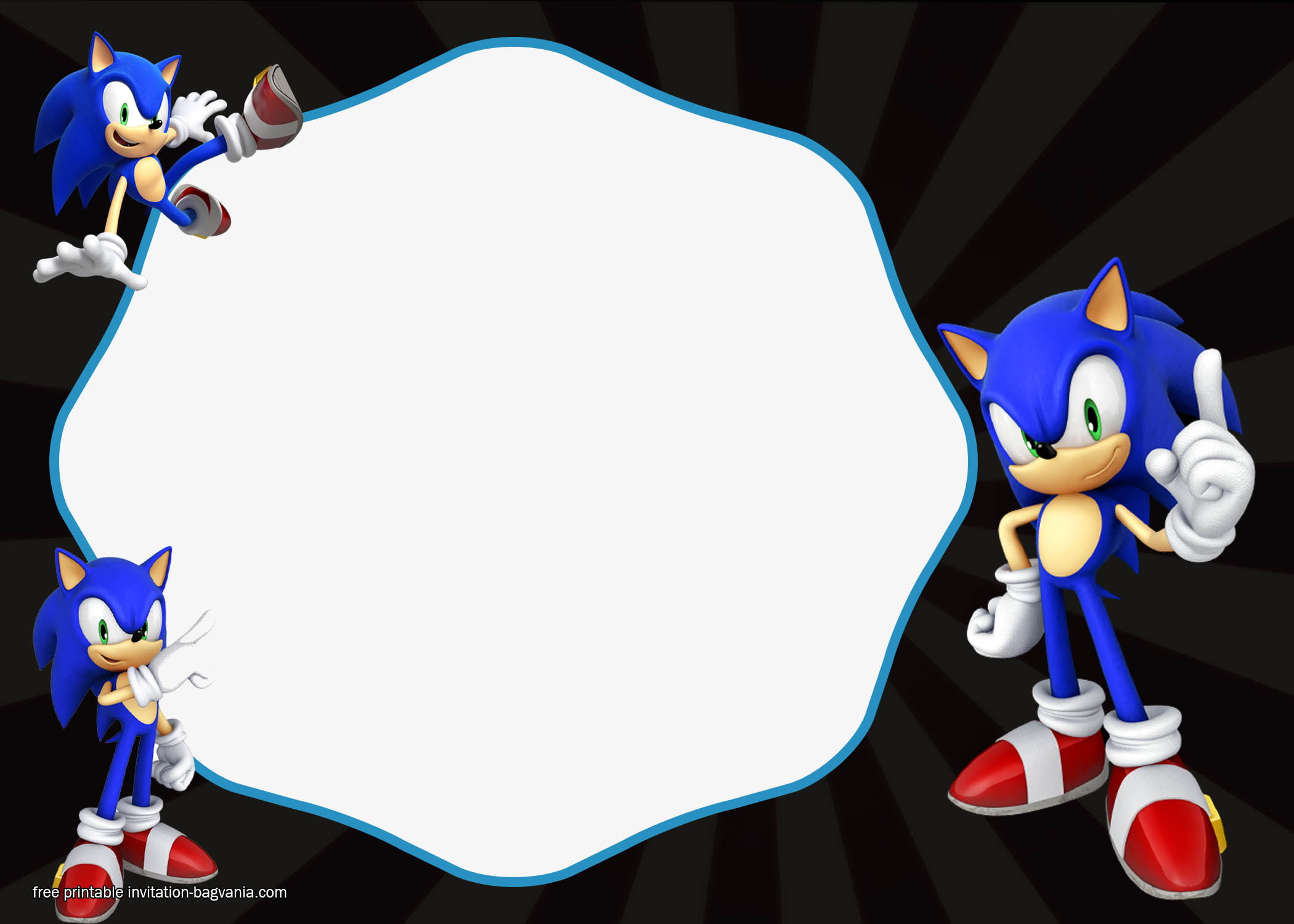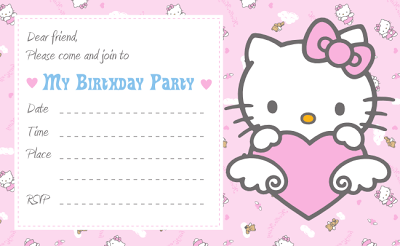Pattern recognition is more than just a fun activity for kids; it’s a powerful tool for developing essential cognitive skills. From helping young children understand sequences and predict outcomes to enhancing memory and logic in older kids, pattern recognition activities lay a foundation for problem-solving and critical thinking. This versatile activity can be tailored to different age groups, making it a valuable resource for parents and educators alike.
This is also such a great activity to keep young children occupied when the family is having a get-together, a birthday party or a play date! Whether you’re just getting started with simple patterns or ready to introduce more complex sequences, pattern recognition is an engaging way to support kids’ learning journeys.
What’s even greater is how there are so many online resources out there that provide free pattern recognition activity templates that you can download. In this article we will also help point you to the right direction to get started with this particular kids’ activity. So let’s dive into the benefits of pattern recognition and explore ways to adjust it to any age group, and to invite families, teachers, and friends to join in on the fun!
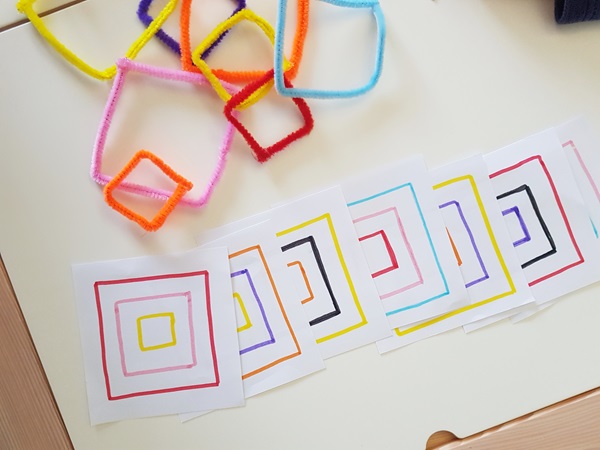
Benefits of Pattern Recognition for Young Children
Pattern recognition activities offer a range of cognitive and developmental benefits for children. Here are some of the key advantages:
1. Develops Early Math Skills
Recognizing patterns is a foundational skill in math, as it helps children understand sequences, categorize objects, and predict outcomes. This skill lays the groundwork for more advanced math concepts, like addition, multiplication, and even algebra.
2. Enhances Problem-Solving Abilities
By identifying and extending patterns, children learn to think critically and logically. They start recognizing rules and structures, which are crucial for problem-solving and strategic thinking. As they grow, these skills help them tackle complex problems in math, science, and other areas.
3. Boosts Memory and Concentration
Pattern recognition activities require focus and memorization, which help strengthen both short-term and long-term memory. Children need to remember sequences or rules, which builds concentration and strengthens their ability to retain information over time.
4. Supports Language and Reading Skills
Patterns play a big role in language learning, as they help children recognize word structures, rhyming sequences, and sentence patterns. This foundational skill can improve their reading comprehension and vocabulary development, as children become better at identifying syllables, phonics, and word families.
5. Encourages Creativity and Flexibility
Recognizing and creating patterns can be highly creative, especially when children use shapes, colors, sounds, or movements. This encourages them to think outside the box, make new connections, and try out different sequences, boosting their creativity and mental flexibility.
6. Builds Organizational and Sequencing Skills
Pattern recognition encourages children to organize and arrange items systematically, helping them learn sequencing and categorization. These skills are important for following directions, completing tasks in steps, and understanding order, all of which are critical for academic success and daily routines.
7. Supports Social and Cooperative Skills
Pattern games and group activities give children a chance to collaborate and communicate with others, enhancing their social skills. As they take turns and explain patterns to each other, they build teamwork, patience, and communication.
8. Promotes Confidence and Independence
Successfully identifying and creating patterns builds children’s confidence in their own reasoning and decision-making abilities. As they experiment with more complex sequences, they become more independent learners, feeling empowered to solve problems and discover new things on their own.
Pattern recognition activities are a fun way to nurture essential cognitive skills, fostering a foundation that will support children’s growth across many areas.
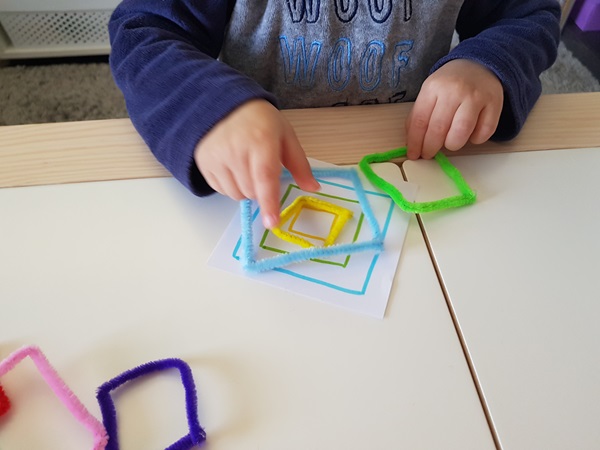
Pattern Recognition: Free Downloadable Templates
There are so many resources out there that can help you get started on the pattern recognition activity with your children, from simple “which color comes next?” exercise to more complex patterns. The most important thing is to know which templates are the best to tailor to your children’s age and cognitive development.
1. Which Color Comes Next?
If you are doing the pattern recognition activity with young children ages 1 to 3, an activity in which they can recognize which color comes next is the best option. Super Star Worksheets have a number of free downloadable templates to start you off, with simple, basic and repetitive visual patterns. You can also use everyday objects with these worksheets to keep it fun and relatable.
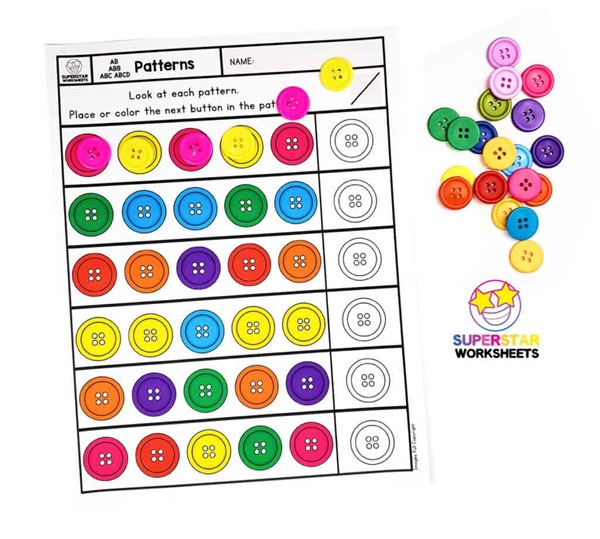

2. What Shape Comes Next?
This type of pattern recognition activity is tailored for older toddlers, around 3 to 5 years old. For the free downloadable templates, check out Semesta Ibu, which template involves recognizing the next color and shape in the sequence.
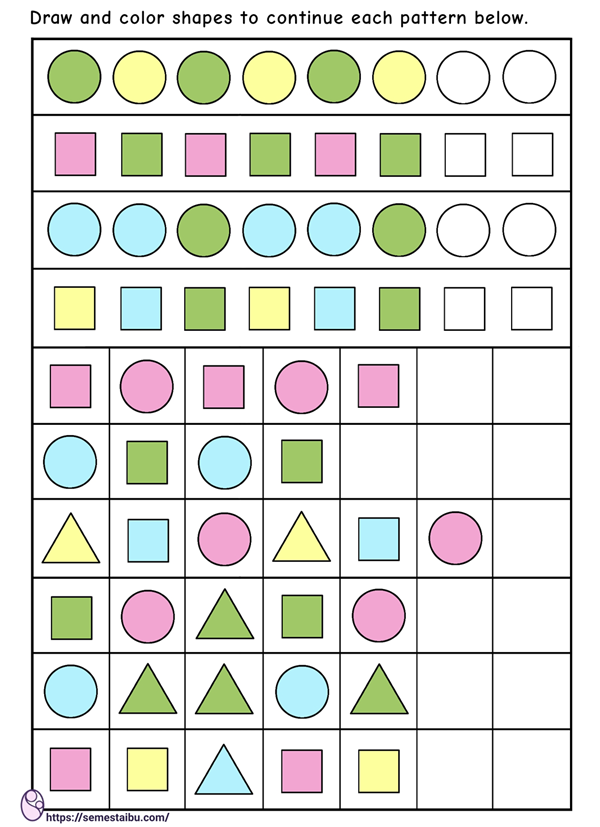
You can also try free templates from Kiddo Worksheets, they have a collection of templates that you can download and print for your children’s pattern recognition activity. When using this worksheets, your children also get to draw and color the different shapes that comes next in the sequence, keeping them occupied, boosting their creativity and making it more fun for your kids and friends their age!
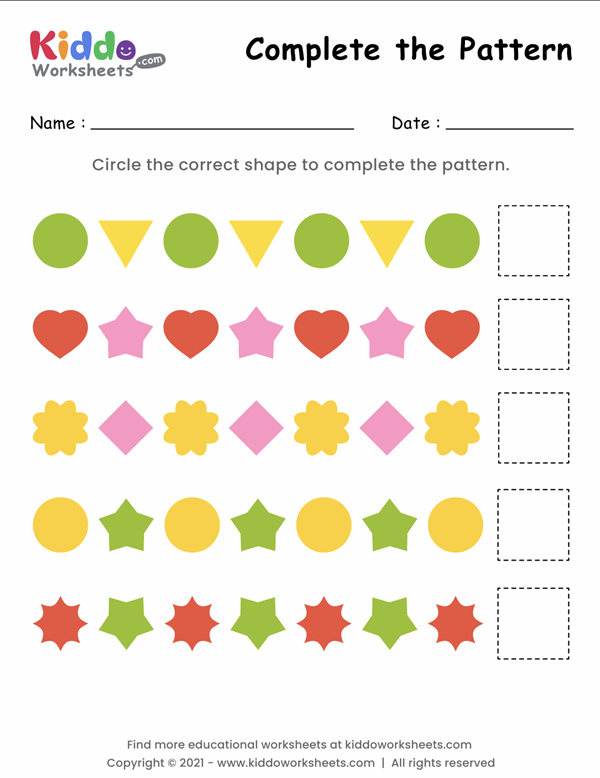
Some other free templates that you want to check out would be from Super Star Worksheets. Apart from simple patterns, they also offer templates for more complex patterns, which also combines other skills like cutting and pasting. Plus, they have many amazing and cute designs that the kids will like.
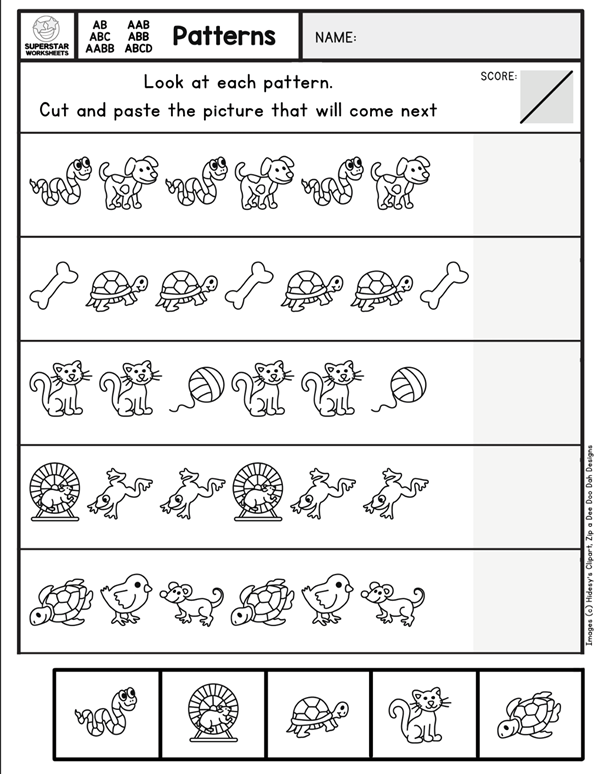
3. Missing Number Pattern Recognition
For older children, those in elementary school ages, you can incorporate letters and numbers in their pattern recognition activity. This worksheet from Super Star Worksheets is one great example for number pattern recognition, it also involves more thinking since the missing numbers are in the middle, not at the end, so try these out!

4. DIY Pattern Recognition Activity
Besides printable templates and worksheets, there are also other ways to do pattern recognition activity at home and they are just as fun! Here are a few ideas for DIY pattern recognition that you can do with items that you can easily get:
- Pasta Patterns: Dye pasta in different colors, then encourage kids to make patterns like red-blue-red. They can string the pasta onto yarn for a fun pattern-making necklace!
- Sticker Sequences: Use two types of stickers (e.g., stars and hearts) to make simple patterns on paper. Let your child replicate or extend the pattern, helping them get familiar with the idea of sequencing.
- Shape Blocks: Cut out shapes from cardboard (squares, circles, triangles) and color them. Use these as simple pattern pieces for arranging or stacking.
- DIY Pattern Cubes: Draw patterns or symbols on each side of small cubes (you can use wooden blocks or make cardboard cubes). Roll two cubes and have kids identify the pattern, or challenge them to create patterns by aligning multiple cubes in sequence.
- Colorful Clothespin Patterns: Paint clothespins in different colors and clip them onto a ruler in alternating patterns (e.g., two blues, one red). Kids can copy or create new sequences, adding a hands-on element.
Tips for Making It Fun
Some children do not always get excited when they are handed paper and worksheets, and they might not want to get into this activity. So here are a few tips to keep things light and fun:
- Make It a Game: Turn it into a matching or guessing game by covering part of the pattern and having kids guess what comes next.
- Involve the Outdoors: Collect items like leaves, rocks, or flowers, and create natural patterns together.
- Build on Interests: If your child loves animals, make patterns with animal stickers or toys; if they love cars, use cars for pattern play.
Inviting Others to Join the Fun
Inviting other parents and their young children to join a pattern recognition activity can be a wonderful way to make it a social, interactive, and fun experience for everyone. Here are some ideas to get parents and kids involved:
Host a “Pattern Playdate”: Set up a special day and invite other parents and kids to join a “Pattern Playdate” at your home, a park, or a community space. Mention that you’ll have a mix of easy, hands-on activities like bead threading, color matching, or even snack patterns with treats like fruit and crackers. A theme like “Pattern Party” makes it sound exciting and unique!
Create a Social Media or Group Message Invite: If you’re part of a parenting group on social media or have a group chat, create a friendly message inviting others to a fun and educational pattern activity session. Include a brief description, like, “We’re organizing a fun pattern recognition day for our little ones with colorful beads, stickers, and nature patterns! It’s a great way for kids to boost their math and problem-solving skills while having fun together.”
Send Out DIY Pattern Kits: If meeting in person isn’t feasible, create DIY pattern kits and drop them off at each parent’s home or send a list of materials they’ll need. Include a few suggested activities, like a color-matching game or a pattern puzzle. Then, invite everyone to share photos of their kids’ creations in a group chat or online. You could even have a virtual call to see each child’s progress and cheer them on!
Share Benefits to Build Interest: When inviting other parents, mention a few of the benefits of pattern recognition, like how it builds math skills, supports early reading, and boosts memory. Many parents will be excited to join once they understand how valuable and easy these activities are!
You can also check out our free invitation templates, they are completely free to download and easy to edit. Sending out an invitation with these templates might be a fun way to get others excited to come to your “pattern party”. Check out the rest of the templates right here: 11+ Colorful Rainbow Invitation Card Templates For A Whimsical Birthday Party and 7+ Cute Cartoon Animals For Kids Birthday Invitation Templates.


By making the invitation engaging and offering a little structure, you can create a welcoming environment for parents and kids to enjoy pattern recognition together. It’s a great way for everyone to bond and for children to have fun while learning valuable skills!
Conclusion
Incorporating pattern recognition activities into playtime is a fantastic way for young children to develop essential skills in a fun, engaging environment. From boosting early math understanding to enhancing problem-solving and memory, pattern recognition supports growth in many areas crucial for academic and cognitive development. These activities are easy to adapt for different age groups, making them a valuable tool for parents and caregivers looking to encourage learning through play.
Inviting other families to join in on pattern recognition fun can make the experience even more enriching. Group activities foster social skills, collaboration, and creativity as children work together and learn from each other. By organizing simple playdates, nature walks, or themed events, parents can create a shared learning environment that’s enjoyable for kids and adults alike. With just a few materials and a spirit of discovery, pattern play becomes a memorable and beneficial activity for everyone involved.

























